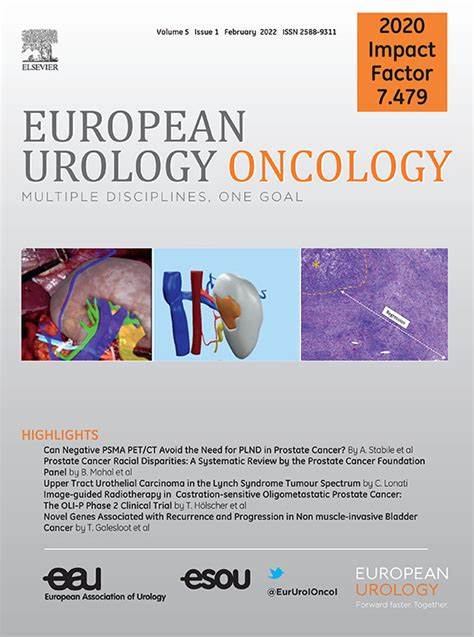Niraparib and Abiraterone Acetate plus Prednisone in Metastatic Castration-resistant Prostate Cancer: Final Overall Survival Analysis for the Phase 3 MAGNITUDE Trial
IF 9.3
1区 医学
Q1 ONCOLOGY
引用次数: 0
Abstract
Background and objective
The phase 3 MAGNITUDE trial previously met its primary endpoint of an improvement in radiographic progression-free survival with niraparib + abiraterone acetate and prednisone (AAP) versus placebo + AAP in patients with metastatic castration-resistant prostate cancer (mCRPC) and alterations in genes involved in DNA homologous recombination repair (HRR+), particularly in BRCA1/2.
Methods
Patients were prospectively screened for HRR alterations and randomized 1:1 to niraparib + AAP (n = 212) or placebo + AAP (n = 211). We report results from the prespecified, event-driven, final analysis of secondary efficacy endpoints.
Key findings and limitations
Final analysis at median follow-up of 37.3 mo revealed no difference in overall survival (OS) between niraparib + AAP and placebo + AAP in the HRR+ population (hazard ratio [HR] 0.931, 95% confidence interval [CI] 0.720–1.203; p = 0.585) or the subgroup with BRCA1/2 alterations (HR 0.788, 95% CI 0.554–1.120; nominal p = 0.183). Prespecified multivariate analyses adjusted for baseline prognostic factors showed a trend toward longer OS with niraparib + AAP over placebo + AAP in the HRR+ population (HR 0.785, 95% CI 0.606–1.016; nominal p = 0.066) and the BRCA1/2 subgroup (HR 0.663, 95% CI 0.464–0.947; nominal p = 0.024). Niraparib + AAP led to a statistically significant, clinically meaningful improvement in time to symptomatic progression in both the HRR+ population (HR 0.547, 95% CI 0.396–0.754; p = 0.006) and the BRCA1/2 subgroup (HR 0.562, 95% CI 0.371–0.849; nominal p = 0.006), and a clinically meaningful improvement in time to cytotoxic chemotherapy in the HRR+ population (HR 0.688, 95% CI 0.499–0.950; p = 0.022) and the BRCA1/2 subgroup (HR 0.598, 95% CI 0.387–0.924; nominal p = 0.019) in comparison to placebo + AAP. The niraparib + AAP safety profile remains unchanged at longer follow-up; adverse events were primarily hematologic and manageable.
Conclusions and clinical implications
The MAGNITUDE final analysis showed that patients with HRR+ mCRPC, including those with the approved indication of BRCA-altered mCRPC, generally continue to benefit from first-line treatment with niraparib + AAP in comparison to placebo + AAP.
尼拉帕尼、醋酸阿比特龙加强的松治疗转移性去势抵抗性前列腺癌:3期量级试验的最终总生存期分析
背景和目的:3期量级试验之前达到了其主要终点,即在转移性阉切抵抗性前列腺癌(mCRPC)和参与DNA同源重组修复(HRR+)的基因改变的患者中,尼拉帕尼+醋酸阿比特龙和泼尼松(AAP)与安慰剂+ AAP相比,放射学无进展生存率的改善,特别是在BRCA1/2中。方法:对患者进行HRR改变的前瞻性筛选,并以1:1的比例随机分配到尼拉帕尼+ AAP (n = 212)或安慰剂+ AAP (n = 211)。我们报告的结果来自预先指定的、事件驱动的、次要疗效终点的最终分析。主要发现和局限性:中位随访37.3个月的最终分析显示,在HRR+人群中,尼拉帕尼+ AAP与安慰剂+ AAP的总生存期(OS)无差异(风险比[HR] 0.931, 95%可信区间[CI] 0.720-1.203;p = 0.585)或BRCA1/2改变亚组(HR 0.788, 95% CI 0.554-1.120;名义p = 0.183)。调整基线预后因素的预先指定多变量分析显示,在HRR+人群中,尼拉帕尼+ AAP比安慰剂+ AAP有更长的生存期趋势(HR 0.785, 95% CI 0.606-1.016;名义p = 0.066)和BRCA1/2亚组(HR 0.663, 95% CI 0.464-0.947;名义p = 0.024)。在HRR+人群中,尼拉帕尼+ AAP在症状进展时间上具有统计学意义,具有临床意义的改善(HR 0.547, 95% CI 0.396-0.754;p = 0.006)和BRCA1/2亚组(HR 0.562, 95% CI 0.371-0.849;名义p = 0.006),在HRR+人群中,到细胞毒性化疗的时间有临床意义的改善(HR 0.688, 95% CI 0.499-0.950;p = 0.022)和BRCA1/2亚组(HR 0.598, 95% CI 0.387-0.924;名义p = 0.019),与安慰剂+ AAP相比。尼拉帕尼+ AAP的安全性在更长时间的随访中保持不变;不良事件主要是血液学和可控的。结论和临床意义:MAGNITUDE最终分析显示,HRR+ mCRPC患者,包括那些已批准brca改变mCRPC适应症的患者,与安慰剂+ AAP相比,一般继续从尼拉帕尼+ AAP一线治疗中获益。
本文章由计算机程序翻译,如有差异,请以英文原文为准。
求助全文
约1分钟内获得全文
求助全文
来源期刊

European urology oncology
Multiple-
CiteScore
15.50
自引率
2.40%
发文量
128
审稿时长
20 days
期刊介绍:
Journal Name: European Urology Oncology
Affiliation: Official Journal of the European Association of Urology
Focus:
First official publication of the EAU fully devoted to the study of genitourinary malignancies
Aims to deliver high-quality research
Content:
Includes original articles, opinion piece editorials, and invited reviews
Covers clinical, basic, and translational research
Publication Frequency: Six times a year in electronic format
 求助内容:
求助内容: 应助结果提醒方式:
应助结果提醒方式:


